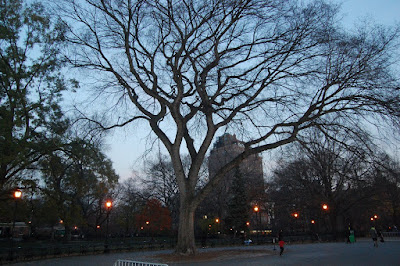In 1966 a Hindu Sadhu (a religious and spiritual leader) began
singing and preaching under a tree in Tompkins Square Park in the East Village
of New York City. This Sadhu, Abhay Charanaravinda Bhaktivedanta Swami Prabhupada,
in his preaching and singing underneath that elm tree began the movement of
Hare Krishna in the United States. Thought of as a sect of Gaudiya Vaishnavism,
a religious movement founded in India, Hare Krishna has seven purposes that aim
the devotee towards deeper spirituality, spreading their spiritual knowledge
and living a simpler life.
 Followers
of Hare Krishna gathered in the park to chant their 16-word phrase, dance and
play instruments. The elm tree under which such gatherings took place is now
memorialized and worshiped by the devotees of the religion and is recognized by
a plaque, installed by the New York City Parks and Recreation department. That
this tree is in a public park, and not enclosed by fences as the other elm
trees are in Tompkins Square Park, parallels the goals of gatherers in 1966.
They wanted to spread the message of their religion with chanting and dancing
and singing and preaching, and to attract followers, they would pass out
pamphlets to passersby.
Followers
of Hare Krishna gathered in the park to chant their 16-word phrase, dance and
play instruments. The elm tree under which such gatherings took place is now
memorialized and worshiped by the devotees of the religion and is recognized by
a plaque, installed by the New York City Parks and Recreation department. That
this tree is in a public park, and not enclosed by fences as the other elm
trees are in Tompkins Square Park, parallels the goals of gatherers in 1966.
They wanted to spread the message of their religion with chanting and dancing
and singing and preaching, and to attract followers, they would pass out
pamphlets to passersby.
In
attendance of the inaugural outdoor gathering was poet Allen Ginsberg, whose
representative character in Jack Kerouac’s, The Dharma Bums, Alvah
Goldbook, was described as someone not entirely onboard with Buddhism practiced
by main characters Japhy and Ray (page 33). That Ginsberg attended the Hare
Krishna outdoor session in 1966 shows the plurality and diversity through which
religion can be attained and by whom. His character clearly had no affinity for
the Buddhism that his friends practiced in The Dharma Bums, written
eight years prior to the establishment of Hare Krishna in the United States,
however, in diversity of religion, different people will be attracted to
different kinds of religious practices.
Occupying
a public space, this tree is symbolic of the notion that a variety of religion,
or no religion at all, can be attainable to all. Of course not one religion
will be applicable to all, but the application of various religions onto the
lives of various individuals is important to respect and acknowledge. Not one
religion is more important than another, and the application of such religion
is not more important or more valid than the application of another.
The point
that I am trying to make is the fact that this tree, which is worshipped by certain
religious people, is in public, affirms that the religious experiences of
others are valid and should not be confined by others who do not share in the
same belief. We are granted the right to practice religion freely and in doing
so, the accessibility to and of religion increases.

No comments:
Post a Comment